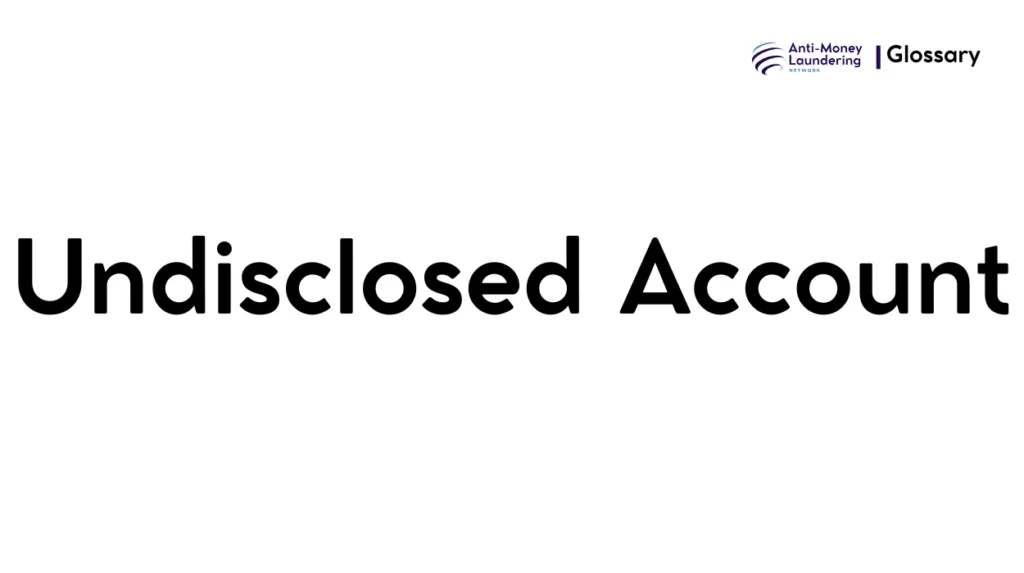Definition
An undisclosed account in the context of Anti-Money Laundering (AML) refers to a financial account held by an individual or entity that is not properly identified or declared to the relevant financial institution or regulatory authorities. This means the account is deliberately concealed or not fully disclosed, including details about its beneficial owner, to evade regulatory scrutiny, tax obligations, or AML compliance checks. Such accounts facilitate illicit activities like money laundering by hiding the true ownership and source of funds.
Purpose and Regulatory Basis
Undisclosed accounts compromise the transparency essential for effective AML compliance. They obstruct the ability of financial institutions to perform Customer Due Diligence (CDD) and Know Your Customer (KYC) procedures, thereby increasing the risk of financial crime such as money laundering, terrorist financing, and tax evasion.
Global and national AML regulations emphasize the detection and prevention of undisclosed accounts:
- The Financial Action Task Force (FATF) recommends countries to enforce strict controls to prevent anonymous or undisclosed ownership of accounts.
- The USA PATRIOT Act mandates thorough customer identity verification to uncover undisclosed interests in accounts.
- The European Union’s Anti-Money Laundering Directives (AMLD) require transparency in ownership and source of funds to prevent the misuse of accounts.
These frameworks collectively require institutions to ensure no account is maintained without full disclosure of ownership and origin of funds.
When and How it Applies
Undisclosed accounts become relevant in scenarios such as:
- When clients open accounts through intermediaries without revealing the ultimate beneficial owner.
- Use of omnibus accounts where multiple client funds are pooled without clear disclosure of who owns what.
- Offshore accounts established to hide assets and avoid detection.
- Accounts used for transactions inconsistent with the customer’s profile or suspicious by nature.
Financial institutions must be vigilant in identifying such accounts during onboarding, ongoing monitoring, and transaction screening. Detection triggers include unusual account activity, reluctance to provide ownership information, or linkage to high-risk jurisdictions.
Types or Variants of Undisclosed Accounts
Undisclosed accounts may take various forms, including:
- Nominee accounts where the beneficial owner’s identity is masked by a nominee or agent.
- Omnibus accounts that aggregate multiple clients’ assets without individual identification.
- Offshore accounts registered under fake or third-party names.
- Shadow accounts used unofficially internally within institutions, not reported externally.
Each type carries different AML risks and requires tailored compliance responses.
Procedures and Implementation
To comply with AML regulations, institutions must implement robust procedures:
- Conduct comprehensive KYC to verify account holders’ identities and beneficial ownership.
- Employ ongoing Customer Due Diligence (CDD) to monitor for signs of undisclosed ownership.
- Use technology-assisted transaction monitoring systems to flag suspicious activities indicating undisclosed interests.
- Perform enhanced due diligence for high-risk accounts and jurisdictions.
- Maintain transparent records and audit trails linking accounts to their legitimate owners.
These controls help ensure no account remains undisclosed and enable timely reporting of suspicious activity.
Impact on Customers/Clients
From a client’s perspective, maintaining an undisclosed account violates regulations and may lead to:
- Account closure or transaction restrictions by the financial institution.
- Legal consequences including fines, prosecution, or other penalties.
- Increased scrutiny and loss of trust from financial service providers.
Clients are entitled to transparent communication and clear instructions on disclosure requirements during account opening and servicing.
Duration, Review, and Resolution
Institutions must continuously review accounts to detect undisclosed statuses throughout the relationship:
- Initial onboarding is critical for disclosure.
- Periodic account reviews and risk assessments are mandated under AML guidelines.
- Suspicious undisclosed accounts must be reported to authorities and resolved by disclosure or account termination.
Ongoing compliance ensures no hidden accounts persist, protecting the integrity of the financial system.
Reporting and Compliance Duties
Financial institutions are obligated to:
- Report suspicious transactions related to undisclosed accounts via Suspicious Activity Reports (SARs).
- Maintain records demonstrating due diligence and monitoring efforts.
- Cooperate with regulatory and enforcement agencies.
Non-compliance can lead to heavy fines, regulatory sanctions, and reputational damage.
Related AML Terms
Understanding undisclosed accounts requires familiarity with related concepts:
- Beneficial Owner: The person who ultimately owns or controls an account.
- Know Your Customer (KYC): Identifying and verifying customers to prevent undisclosed ownership.
- Customer Due Diligence (CDD): Ongoing risk assessment of customers and accounts.
- Suspicious Activity Reporting (SAR): Reporting suspicious account activities.
- Omnibus Account: An account holding multiple entities’ assets without detailed disclosure.
Challenges and Best Practices
Challenges in managing undisclosed accounts include:
- Complex ownership structures obscuring real owners.
- Offshore jurisdictions with strict privacy laws.
- Technological gaps in transaction monitoring.
Best practices to address these:
- Use advanced analytics and AI for transaction monitoring.
- Strengthen KYC and enhanced due diligence for high-risk clients.
- Collaborate with global regulators and share intelligence.
- Regular training for staff on detecting undisclosed accounts.
Recent Developments
Technological advances like blockchain analytics and AI-powered detection tools are improving identification of undisclosed accounts. Regulators continue to tighten transparency laws globally, with increasing focus on ultimate beneficial ownership and real-time monitoring. Compliance programs are evolving to integrate data from various sources to uncover hidden accounts promptly.
Undisclosed accounts pose a significant AML risk by concealing ownership and enabling illicit financial flows. Through regulatory frameworks like FATF, USA PATRIOT Act, and EU AMLD, financial institutions are mandated to establish stringent KYC, CDD, and monitoring systems to detect and prevent undisclosed accounts. Effective AML compliance mitigates financial crime risks while ensuring transparency and trust in the global financial system.

